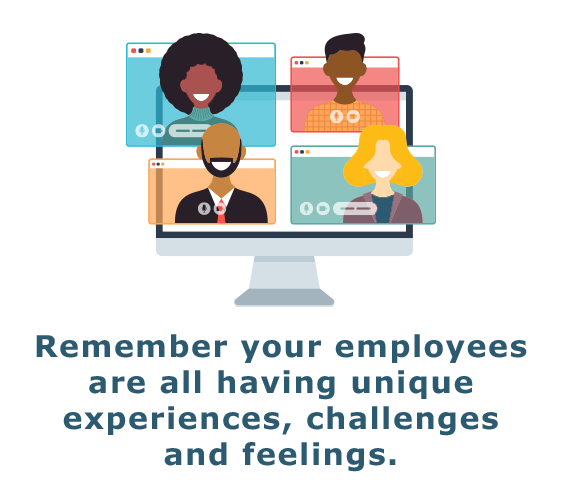There’s no doubt all individuals have been affected by the past year’s events in a variety of ways. Especially as many employees begin to experience “pandemic fatigue” and some regions are again tightening restrictions, it’s important to ensure current practices are still working. Now is the time for insurers to rethink all areas of business, including how they engage and energize their employees.
According to Gallup, employee engagement rates have fluctuated more in 2020 than any other year since the firm began its tracking two decades ago. Reestablishing a strong employee engagement program is imperative for success moving into 2021. There are a number of ways you can reenergize your teams and prepare to move forward stronger than ever.
 Focus on your company values.
Focus on your company values.
While increasing employee engagement during a pandemic may seem like a potentially overwhelming task, let your company values guide your thought process and decisions. If your company prides itself on collaboration, how are you ensuring that’s a priority in the remote environment? If personal growth and development is a value, has it been given adequate consideration in 2020, or has it been pushed to the sidelines? Determine how these values can be incorporated into the everyday fabric of your culture.
Foster a culture of connection.
Now more than ever, a feeling of connection is vital. Encourage employees to focus on building and strengthening relationships within the organization. Schedule virtual coffee breaks with people from different departments and facilitate interdepartmental networking. You may even consider developing a formalized program that brings together employees who may not otherwise cross paths. Remember to pay special attention to new hires. Starting a new job is always daunting; make a concerted effort to engage them with individuals across the team and organization from day one.
 Along with networking, expand special project teams and committees to integrate people who may not have otherwise been able to participate. Team up employees for projects to help keep daily activities from feeling stale. Working on a team can keep individuals moving forward, hold them accountable and even be fun.
Along with networking, expand special project teams and committees to integrate people who may not have otherwise been able to participate. Team up employees for projects to help keep daily activities from feeling stale. Working on a team can keep individuals moving forward, hold them accountable and even be fun.
Listen to individual employee needs.
Personal challenges can be heavy during this time. Ask how you can support individuals as they navigate family demands, mental and physical health, childcare, virtual school and more. This may mean being flexible with hours and getting creative around how projects and deadlines are distributed. You may consider allowing individuals to bank hours or work longer days to create a four-day workweek. At the same time, be mindful of employees’ emotional wellbeing. Encourage them to take time off even if they’re not leaving their home.
or work longer days to create a four-day workweek. At the same time, be mindful of employees’ emotional wellbeing. Encourage them to take time off even if they’re not leaving their home.
In addition to being flexible with schedules and projects, ask if there are any obstacles you might be able to remove. Would two screens help employees be even more productive? Are certain employees experiencing slow internet connections because multiple individuals are online for work and school at their home? There may be simple solutions that can make a huge difference and amplify your employees’ remote experiences.
Prioritize frequent and ongoing communication.
Help counteract employees’ feelings of uncertainty with frequent and transparent communication. Create a plan that includes regular one-on-ones, team huddles and departmental meetings. Along with a sense of unity, this can give employees a chance to interact, act questions and gain clarity on various topics and changes. Hold companywide town hall meetings to provide individuals a chance to hear insight and plans directly from members of the executive team. Keep these events interactive, allow for humor when appropriate, and celebrate even small milestones and successes.
Within departments and functions, encourage conversations around goals and best practices. It’s likely even high-performing employees aren’t meeting the goals they originally set for the year. Talking with others going through similar situations can provide a welcomed support system. Additionally, it can help individuals – especially those typically working as individual contributors – feel more connected and less alone.
 Make it about more than work.
Make it about more than work.
Even though post-work happy hours and all-team lunches aren’t possible face-to-face, think of how the bonding component of these activities can translate to the at-home environment. Ideas may be simple, such as taking a virtual team lunch break. Or, activities could be more involved or interest-focused, such as participating in a virtual cooking class or starting a book club.
Small expressions of gratitude and acknowledgement can also add up. Some organizations are putting together care packages, which may include specialty snacks and treats, company-branded hand sanitizer and face masks, or even gift cards. If sending small items is outside your budget, consider a handwritten note to let employees know you’re thinking of them and appreciate their dedication.
Increase recognition and incentives.
Rethink how you’re acknowledging employee accomplishments in the current environment. It’s been a hard year, and enhanced recognition programs and incentives can help create much-needed positive energy. Ask employees if your existing programs are still working for them – do they have any ideas for making them more effective?
What company-wide projects could be made into a contest? Friendly competition can bring those who are more introverted out of their shells and help connect individuals who are feeling isolated. In addition to business-specific competitions, create challenges around wellness. This could be a contest around daily steps, water intake or anything else that can unite individuals and help them connect with the company. Not only do these contests help promote employee health, they’re also great conversation starters for those who may not know one another well.
 As you focus on enhancing engagement, remember your employees are all having unique experiences, challenges and feelings. What may have worked last year, or even earlier on in the pandemic, may not be working anymore. It’s impossible to create programs that will resonate without seeking feedback and opinions from staff. Take the time to solicit feedback on specific programs, areas you can do better and key challenges. Short surveys and conversations can provide a wealth of valuable information.
As you focus on enhancing engagement, remember your employees are all having unique experiences, challenges and feelings. What may have worked last year, or even earlier on in the pandemic, may not be working anymore. It’s impossible to create programs that will resonate without seeking feedback and opinions from staff. Take the time to solicit feedback on specific programs, areas you can do better and key challenges. Short surveys and conversations can provide a wealth of valuable information.
Reevaluating culture, communication and employees’ individual needs all play a role in creating a positive and energizing environment. By being intentional and taking the time to rethink your approach to employee engagement, you’ll be prepared to retain your top performers and help your team be most productive in the next normal.